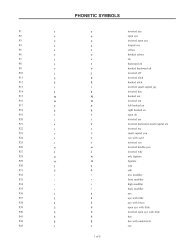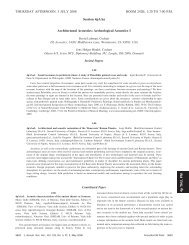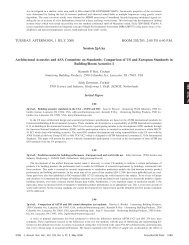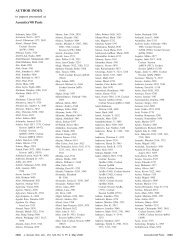Tuesday afternoon, 11 November - The Acoustical Society of America
Tuesday afternoon, 11 November - The Acoustical Society of America
Tuesday afternoon, 11 November - The Acoustical Society of America
Create successful ePaper yourself
Turn your PDF publications into a flip-book with our unique Google optimized e-Paper software.
TUESDAY AFTERNOON, <strong>11</strong> NOVEMBER 2008 LEGENDS 4, 1:30 TO 3:30 P.M.<br />
Session 2pBB<br />
Biomedical Ultrasound/Bioresponse to Vibration: Microbubble Response and Modeling<br />
Tyrone M. Porter, Chair<br />
Boston Univ., Aerospace and Mechanical Eng., <strong>11</strong>0 Cummington St., Boston, MA 02215<br />
1:30<br />
2pBB1. Coupled two-phase model <strong>of</strong> a gas microbubble containing<br />
suspended light absorbing nonoparticles. Elisabetta Sassaroli, Brian E. O’<br />
Neill, and King C.P. Li <strong>The</strong> Methodist Hospital Res. Inst., 6565 Fannin St,<br />
Houston, TX 77030, esassaroli@comcast.net<br />
A mathematical model <strong>of</strong> a micrometer size gas bubble containing nanometer<br />
size light absorbing nanoparticles is presented. A description <strong>of</strong> such<br />
a system can be obtained in terms <strong>of</strong> a coupled two-phase model with the<br />
solid particles in suspension in the gas phase. It is assumed that the suspension<br />
is diluted so that particle-particle interaction can be ignored. Because<br />
the heat exchange between the particles and the gas is <strong>of</strong> main interest in<br />
this calculation, it is assumed in first approximation that the gas and the particles<br />
have the same velocity and pressure. <strong>The</strong> pressure is assumed to be a<br />
function <strong>of</strong> time only. In this case, only the equations <strong>of</strong> continuity and energy<br />
for both the particulate phase and the gas phase are needed. <strong>The</strong> twophase<br />
model is then solved in a linear approximation, and a system <strong>of</strong> four<br />
differential equations with constant coefficients is obtained. <strong>The</strong> system is<br />
diagonalized and the general solution <strong>of</strong> the coupled system is obtained. <strong>The</strong><br />
general solution is a combination <strong>of</strong> exponential decaying oscillatory functions<br />
for the temperature <strong>of</strong> the two phases, the pressure, and the microbubble<br />
radial oscillations. It was found that the oscillatory behavior takes<br />
place in the megahertz range.<br />
1:45<br />
2pBB2. <strong>The</strong> effect <strong>of</strong> scatterer size distribution on the backscatter<br />
coefficient. Michael King Bioacoustics Res. Lab., Dept. <strong>of</strong> Elec. and<br />
Comput. Eng., Univ. <strong>of</strong> Illinois at Urbana-Champaign, Urbana, IL 61801,<br />
mrking2@uiuc.edu, Ernest L. Madsen, Timothy J. Hall Univ. <strong>of</strong><br />
Wisconsin-Madison, Madison, WI 53706, Alexander Haak, Michael L.<br />
Oelze, and William D. O’Brien, Jr. Univ. <strong>of</strong> Illinois at Urbana-Champaign,<br />
Urbana, IL 61801<br />
<strong>The</strong> bias and variance <strong>of</strong> mean scatterer size estimates made from backscatter<br />
coefficients might be reduced by incorporating an estimate <strong>of</strong> scatterer<br />
size distribution into the parameter estimation scheme. Current estimation<br />
schemes generally assume a single scatterer size representing the<br />
volume-weighted mean diameter <strong>of</strong> a distribution. When the mean interrogation<br />
frequency has a ka value near 0.8 for the mean scatterer size, and the<br />
size distribution is relatively narrow, the results are unbiased. However, consideration<br />
<strong>of</strong> the distribution <strong>of</strong> sizes may improve scatterer size estimation,<br />
especially at frequencies for which ka 1. A phantom <strong>of</strong> 2% dry weight<br />
agar spheres with diameters between 90 and 125 µm in a 3.4% agar background<br />
was scanned over a broad frequency range using several transducers,<br />
and the backscatter coefficients were estimated from these data. When accounting<br />
for the size distribution, the mean square error between the measured<br />
and theoretical backscatter coefficients over the frequency range <strong>of</strong><br />
3–14 MHz was reduced by at least 50% in the size range <strong>of</strong> interest. <strong>The</strong>se<br />
results suggest that accounting for the size distribution in backscatter models<br />
will significantly improve the ability to parametrize the backscatter<br />
coefficient. Work supported by NIH CA<strong>11</strong>1289<br />
Contributed Papers<br />
2:00<br />
2pBB3. Modeling <strong>of</strong> the dynamics <strong>of</strong> a coated microbubble confined in a<br />
blood vessel. Sergey Martynov, Eleanor Stride, and Nader Saffari Dept. <strong>of</strong><br />
Mech. Eng., Univ. College London, Torrington Pl., London WC1E 7JE, UK,<br />
e.stride@ntlworld.com<br />
Coated microbubbles have been extensively investigated as contrast<br />
agents for diagnostic ultrasound imaging and more recently for therapeutic<br />
applications such as targeted drug delivery. However, theoretical models for<br />
microbubble dynamics have previously been developed either for encapsulated<br />
bubbles in an infinite volume <strong>of</strong> fluid or for uncoated bubbles in a confined<br />
volume. In the present study, a numerical model is developed to explore<br />
the effects <strong>of</strong> both encapsulation and confinement in a blood vessel<br />
upon the microbubble response in the time domain. Both surfactant-coated<br />
microbubbles and polymeric microspheres are examined for a range <strong>of</strong><br />
vessel:bubble diameter ratios and mechanical properties. <strong>The</strong> model is validated<br />
against other theoretical models <strong>of</strong> oscillating bubbles, and the theory<br />
<strong>of</strong> buckling <strong>of</strong> a thin spherical shell. It will be shown that even at low acoustic<br />
pressures 20 kPa the radial oscillations <strong>of</strong> the bubble and the amplitude<br />
and spectrum <strong>of</strong> the radiated pressure field can be significantly modified as<br />
a result <strong>of</strong> confinement and that these effects are sensitive to the viscoelastic<br />
properties <strong>of</strong> the coating and the vessel. <strong>The</strong> implications for diagnostic and<br />
therapeutic applications <strong>of</strong> microbubbles will be discussed.<br />
2:15<br />
2pBB4. Definition <strong>of</strong> a cavitation index for real time monitoring during<br />
in vitro liposomal drug release. Lucie Somaglino, Guillaume Bouchoux,<br />
Jean-Louis Mestas, Adrien Matias, Jean-Yves Chapelon, and Cyril Lafon<br />
Inserm, U556, 151 cours Albert Thomas, 69424 Lyon, cedex 03, France and<br />
Universit de Lyon, Lyon F-69003, France, lucie.somaglino@inserm.fr<br />
Drug release from liposomes can be activated by ultrasound and inertial<br />
cavitation is assumed to be the main involved mechanism. Broadband noise<br />
is known as a good indicator for such cavitation. <strong>The</strong> feasibility <strong>of</strong> assessing<br />
the extent <strong>of</strong> drug release by acoustic noise measurements has been<br />
investigated. A 1.17-MHz focused transducer 50-mm diameter and 50-mm<br />
focal length was excited with tone-bursts duty cycle: 10%–100%, PRF:<br />
100 Hz–10 kHz, and Ispta 800 W/cm 2 . Emitted noise was registered with<br />
a broadband needle hydrophone and bandpass filtered between the fundamental<br />
and the first harmonic frequency for assessing the instantaneous inertial<br />
cavitation activity. A cavitation index CI was computed by integrating<br />
the filtered signal over time. This index was validated experimentally<br />
using terephthalate oxidized to fluorescent hydroxyterephthalate under the<br />
action <strong>of</strong> free hydroxyl radicals generated by inertial cavitation. <strong>The</strong> hydroxyterephthalate<br />
fluorescence and the CI were well correlated R 2 0.92.<br />
Experiments with liposomes were performed showing very good correlation<br />
between CI and drug release extent from liposomes. <strong>The</strong> definition <strong>of</strong> this CI<br />
allowed applying consistent doses <strong>of</strong> cavitation and performing comparative<br />
tests between different liposome formulations. This work was funded by a<br />
grant from the Norwegian Research Council NANOMAT programme. Epitarget<br />
AS, Norway is acknowledged for the supply <strong>of</strong> liposome samples.<br />
2485 J. Acoust. Soc. Am., Vol. 124, No. 4, Pt. 2, October 2008 156th Meeting: <strong>Acoustical</strong> <strong>Society</strong> <strong>of</strong> <strong>America</strong><br />
2485<br />
2p TUE. PM







